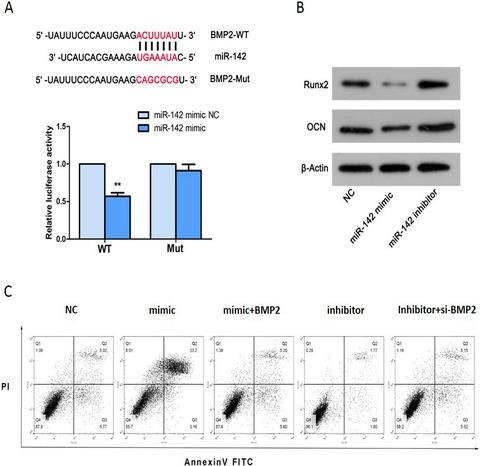当前位置:
X-MOL 学术
›
FEBS Open Bio
›
论文详情
Our official English website, www.x-mol.net, welcomes your
feedback! (Note: you will need to create a separate account there.)
MicroRNA-142 regulates osteoblast differentiation and apoptosis of mouse pre-osteoblast cells by targeting bone morphogenetic protein 2.
FEBS Open Bio ( IF 2.8 ) Pub Date : 2020-07-31 , DOI: 10.1002/2211-5463.12929 Bing Luo 1 , Jiafu Yang 1 , Yi Yuan 1 , Pandeng Hao 1 , Xiaoyan Cheng 2
FEBS Open Bio ( IF 2.8 ) Pub Date : 2020-07-31 , DOI: 10.1002/2211-5463.12929 Bing Luo 1 , Jiafu Yang 1 , Yi Yuan 1 , Pandeng Hao 1 , Xiaoyan Cheng 2
Affiliation

|
Osteoporosis is a common disease that can seriously impair the physical and mental health of the elderly. However, current treatment is unsatisfactory due to the lack of effective therapeutic targets. Abnormal expression and involvement of microRNA‐142 (miR‐142) have been identified in many diseases, including bone‐related diseases. Herein, we explored the effect of miR‐142 on the viability, differentiation and apoptosis of the mouse preosteoblast cell line MC3T3‐E1. We observed that the viability of MC3T3‐E1 cells was significantly inhibited or promoted after transfection of miR‐142 mimic or inhibitor, respectively. The apoptotic rate was dramatically increased by miR‐142 mimic and decreased by inhibitor compared with the negative control group. Bcl‐2 expression was down‐regulated in the miR‐142 mimic group and up‐regulated in the miR‐142 inhibitor group, whereas levels of cleaved caspase‐3 and Bax were increased in the miR‐142 mimic group and reduced in the miR‐142 inhibitor group. Expression changes of Runx2 and Osteocalcin suggest that miR‐142 inhibits the differentiation of osteoblast cells. Moreover, the luciferase reporter assay was used to verify that bone morphogenetic protein 2 (BMP2) is a target of miR‐142. Overexpression of BMP2 repressed the proapoptotic effect of miR‐142 mimic, whereas knockdown of BMP2 abolished the inhibitory effect of miR‐142 inhibitor on the apoptosis of MC3T3‐E1 cells. Furthermore, up‐regulation or down‐regulation of miR‐142 dramatically decreased or increased the ratio of p‐Smad1/5/Smad1 and p‐Smad1/5/Smad5, respectively. Collectively, our results imply that miR‐142 might influence the viability and differentiation of osteoblast cells by regulating BMP2 and BMP/Smad signaling.
中文翻译:

MicroRNA-142通过靶向骨形态发生蛋白2来调节小鼠前成骨细胞的成骨细胞分化和凋亡。
骨质疏松症是严重损害老年人身心健康的常见病。然而,由于缺乏有效的治疗靶点,目前的治疗效果并不令人满意。已在许多疾病中发现 microRNA-142 (miR-142) 的异常表达和参与,包括骨相关疾病。在此,我们探讨了 miR-142 对小鼠前成骨细胞系 MC3T3-E1 活力、分化和凋亡的影响。我们观察到转染 miR-142 模拟物或抑制剂后,MC3T3-E1 细胞的活力分别显着受到抑制或促进。与阴性对照组相比,miR-142模拟组的细胞凋亡率显着增加,而抑制剂的细胞凋亡率则降低。 Bcl-2 表达在 miR-142 模拟组中下调,在 miR-142 抑制剂组中上调,而 cleaved caspase-3 和 Bax 的水平在 miR-142 模拟组中增加,而在 miR-142 抑制剂组中减少‐142 抑制剂组。 Runx2 和骨钙素的表达变化表明 miR-142 抑制成骨细胞的分化。此外,使用荧光素酶报告基因测定来验证骨形态发生蛋白 2 (BMP2) 是 miR-142 的靶标。 BMP2的过表达抑制了miR-142模拟物的促凋亡作用,而BMP2的敲低消除了miR-142抑制剂对MC3T3-E1细胞凋亡的抑制作用。此外,miR-142的上调或下调分别显着降低或增加p-Smad1/5/Smad1和p-Smad1/5/Smad5的比率。总的来说,我们的结果表明 miR-142 可能通过调节 BMP2 和 BMP/Smad 信号传导来影响成骨细胞的活力和分化。
更新日期:2020-07-31
中文翻译:

MicroRNA-142通过靶向骨形态发生蛋白2来调节小鼠前成骨细胞的成骨细胞分化和凋亡。
骨质疏松症是严重损害老年人身心健康的常见病。然而,由于缺乏有效的治疗靶点,目前的治疗效果并不令人满意。已在许多疾病中发现 microRNA-142 (miR-142) 的异常表达和参与,包括骨相关疾病。在此,我们探讨了 miR-142 对小鼠前成骨细胞系 MC3T3-E1 活力、分化和凋亡的影响。我们观察到转染 miR-142 模拟物或抑制剂后,MC3T3-E1 细胞的活力分别显着受到抑制或促进。与阴性对照组相比,miR-142模拟组的细胞凋亡率显着增加,而抑制剂的细胞凋亡率则降低。 Bcl-2 表达在 miR-142 模拟组中下调,在 miR-142 抑制剂组中上调,而 cleaved caspase-3 和 Bax 的水平在 miR-142 模拟组中增加,而在 miR-142 抑制剂组中减少‐142 抑制剂组。 Runx2 和骨钙素的表达变化表明 miR-142 抑制成骨细胞的分化。此外,使用荧光素酶报告基因测定来验证骨形态发生蛋白 2 (BMP2) 是 miR-142 的靶标。 BMP2的过表达抑制了miR-142模拟物的促凋亡作用,而BMP2的敲低消除了miR-142抑制剂对MC3T3-E1细胞凋亡的抑制作用。此外,miR-142的上调或下调分别显着降低或增加p-Smad1/5/Smad1和p-Smad1/5/Smad5的比率。总的来说,我们的结果表明 miR-142 可能通过调节 BMP2 和 BMP/Smad 信号传导来影响成骨细胞的活力和分化。











































 京公网安备 11010802027423号
京公网安备 11010802027423号